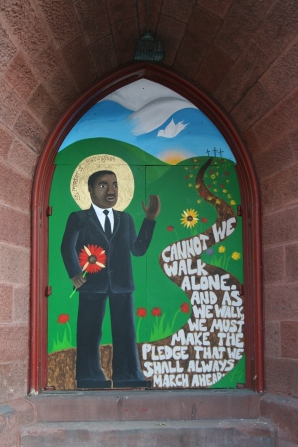Saint Martin of Luther Place: a Historic Congregation’s New Mural

Luther Place: Amanda Weber
Luther Place's second mural, featuring "Saint Martin of Birmingham", watches over 14th street.
Before this week, if you had asked me where “Luther Place” was, I would’ve looked at you blankly, despite the fact that I’ve lived here since 1999. Shame on me, for that. Luther Place Memorial Church sits on Thomas Circle; it’s a brick building you’ve probably passed dozens of times if you walk, bike or drive on 14th street NW. This week, the congregation dedicated a special mural featuring “Saint Martin of Birmingham”, or the Rev. Dr. Martin Luther King, Jr. I spoke to Reverend Karen Brau yesterday about this new piece of public art, her congregation and its history in this city.
::
Tell me about Luther Place.
It’s a congregation that has been part of this city since the 1870s. In the 1960s, when riots happened on 14th street, we were called to open our doors and be a refuge for people at that time. Now we have a ministry for homeless women that serves over 800 women a year with shelter, job placement and help with recovery from addiction.
I’d love to know more about what Luther Place did during the riots–
The congregation made the decision to open the doors of our church, and it became a point of sanctuary for people who needed a place to stay. Luther Place also became a distribution point…other congregations from different parts of the city brought food to us that could be shared with people being affected by what was going on at that time. I think that act was a turning point; in the words of the gospel, you should love your neighbor, care for a stranger. Those words came to life in a very palpable way. And not everyone could deal with that, so that defined the congregation too.
What do you mean by people not dealing with it?
The city was burning. Some people thought, “I live far away, there are other churches in my neighborhood”…those were good excuses. At that point a fair amount of our congregation had moved to the suburbs. So a defining moment for our congregation as a whole became a defining moment for some of the people in it, too. They hadn’t necessarily seen themselves as activists, but when invited by their pastor, they stepped right in. That situation changed people’s lives in a very important way going forward…and that’s part of why it makes sense to have (MLK) on 14th street.
We wanted to do something on 14th st. We knew its history with the riots after Dr. King was assassinated and the burning that went on along the 14th street corridor…so to us it seemed very logical that the icon who should look out on to that street would be Martin Luther King, Jr. If an icon is someone we venerate as holy and a saint, then we feel that he is just that because of his walk with God and his witnessing.
I like that you call him Saint Martin of Birmingham. It appeals to the erstwhile Catholic School student within me.
He is Saint Martin of Birmingham, the letter that he wrote from jail was a pivotal point for the civil rights movement. An articulation of the power of non-violent action. Churches are having a hard time finding out how to be relevant. I think we have so much that we have to learn from people who have been part of the past of our church. Perhaps the reforming that is going on can mean that a Lutheran church can call on a Baptist preacher for inspiration…







